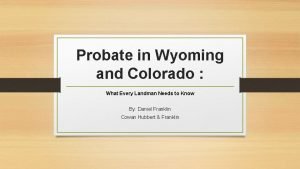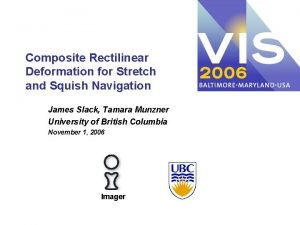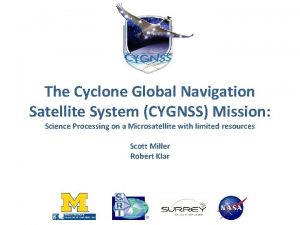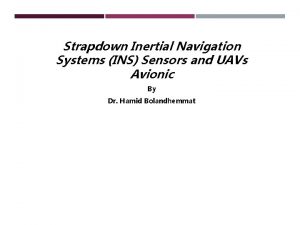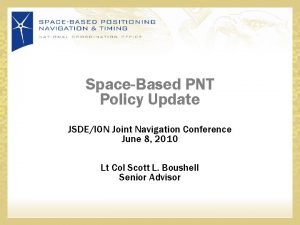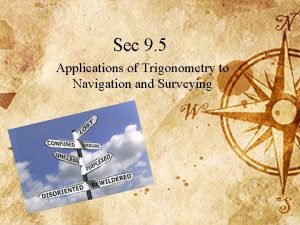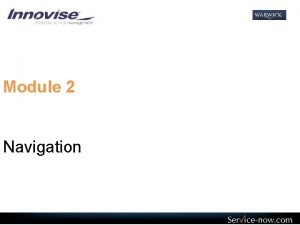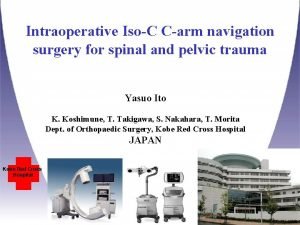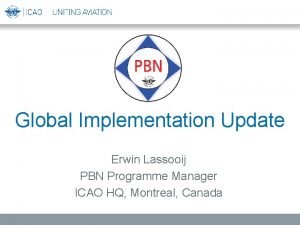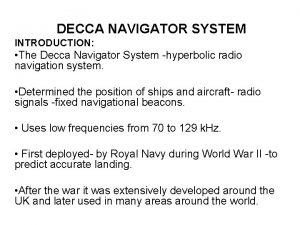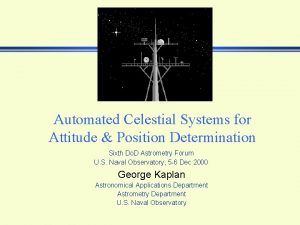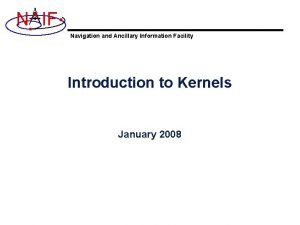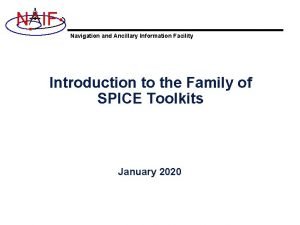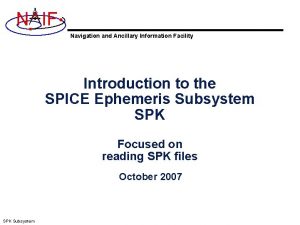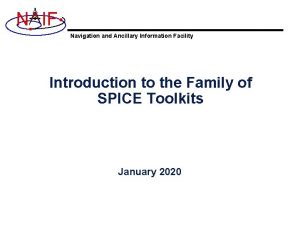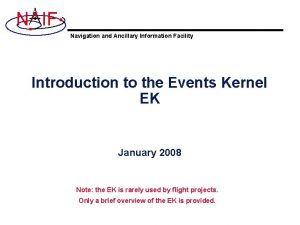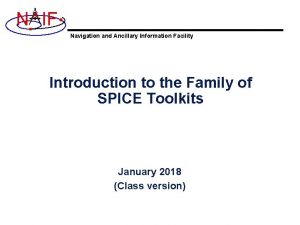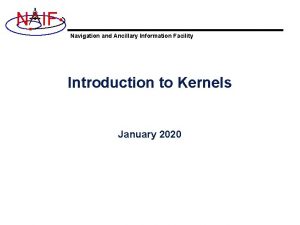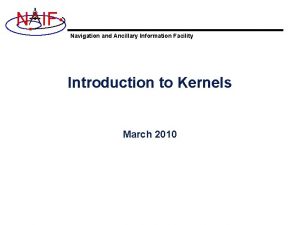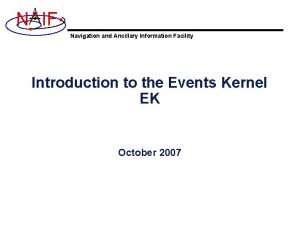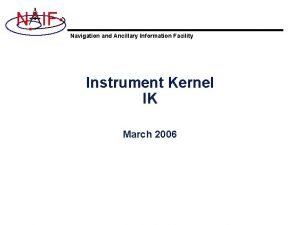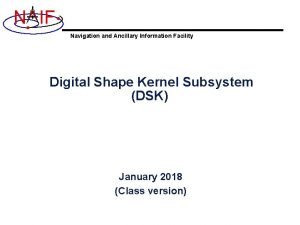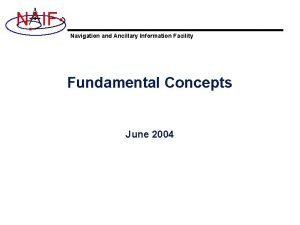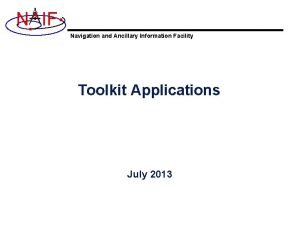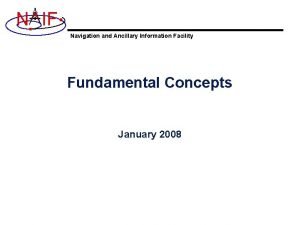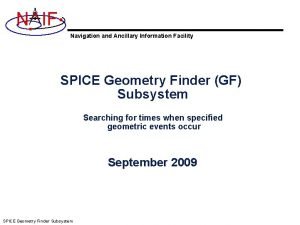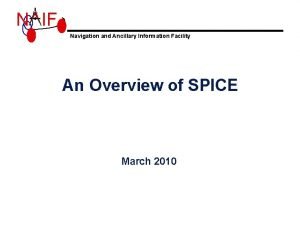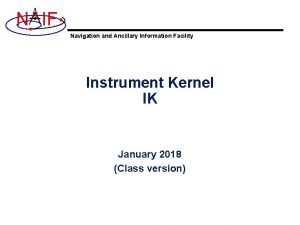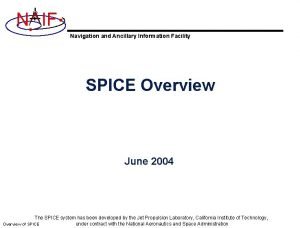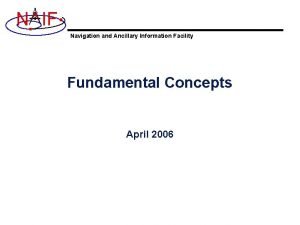N IF Navigation and Ancillary Information Facility Introduction












































- Slides: 44

N IF Navigation and Ancillary Information Facility Introduction to the SPICE Ephemeris Subsystem SPK Focused on reading SPK files January 2018 (Class version)

N IF First… clear your mind! Navigation and Ancillary Information Facility • SPK is probably unlike any previous ephemeris or trajectory representation you’ve used. • We think you’ll find it to be more capable than other ephemeris system architectures. – As such, it’s also a bit more complicated to grasp. • Don’t panic! Shortly you’ll be reading SPK files like a pro. SPK Subsystem 2

N IF Navigation and Ancillary Information Facility Overview of SPICE Ephemeris Data SPK Subsystem 3

N IF A Picture is worth … Navigation and Ancillary Information Facility • We’ll start with a mostly pictorial view of ephemeris data and SPK files, just to ease you into this topic. SPK Subsystem 4

N IF Examples of SPICE Ephemeris Objects Navigation and Ancillary Information Facility Asteroid Comet The head and the tail of every blue arrow are located at “ephemeris objects. ” Antenna feed cone Sun • Solar system barycenter* Spacecraft Earth . . *A barycenter is the center of mass of a system of bodies, such as Saturn plus all of Saturn's satellites, or, the sun and all the planets, satellites, comets and asteroids in the solar system. SPK Subsystem • Communications Station • Lander or rover Satellite Planetary system barycenter* Planet's mass center 5

N IF SPICE Ephemeris Data Navigation and Ancillary Information Facility • An SPK file contains ephemeris (trajectory) data for "ephemeris objects. ” – “Ephemeris” means position and velocity as a function of time » Position + velocity is often referred to as “state” • “Ephemeris objects” are spacecraft, planets, satellites, comets and asteroids. – But the following are also ephemeris objects: » » » the center of mass of our solar system (solar system barycenter) the center of mass of a planet/satellite system (planet barycenter) a rover on the surface of a body a camera on top of a mast on a lander a transmitter cone on a spacecraft a deep space communications antenna on the earth • A single SPK file can contain data for multiple ephemeris objects, and often does. SPK Subsystem 6

N IF Imagine Some Ephemeris Data Navigation and Ancillary Information Facility epoch_1, x 1, y 1, z 1, vx 1, vy 1, vz 1 epoch_2, x 2, y 2, z 2, vx 2, vy 2, vz 2 epoch_3, x 3, y 3, z 3, vx 3, vy 3, vz 3 epoch_4, x 4, y 4, z 4, vx 4, vy 4, vz 4. . . . . etc. . . . . epoch_n, xn, yn, zn, vxn, vyn, vzn Perhaps this is an ASCII table or an Excel spreadsheet containing rows of time-tagged Cartesian state vectors. “epoch” = time It may not be written inside the table or spreadsheet, but perhaps an interface agreement somehow tells you: SPK Subsystem – what object this ephemeris is for – what is the name of the reference frame (“coordinate frame”) in which the data are given – what is the center of motion of the object – what time system is being used for the epochs – maybe also what are the start and stop times of the file » meaning, what are “epoch_1” and “epoch_n” 7

N IF Imagine a Simple Ephemeris File Navigation and Ancillary Information Facility epoch_1, x 1, y 1, z 1, vx 1, vy 1, vz 1 epoch_2, x 2, y 2, z 2, vx 2, vy 2, vz 2 epoch_3, x 3, y 3, z 3, vx 3, vy 3, vz 3 epoch_4, x 4, y 4, z 4, vx 4, vy 4, vz 4. . . . . etc. . . . . epoch_n, xn, yn, zn, vxn, vyn, vzn SPK Subsystem We’ll represent that simple ephemeris data shown on the previous page as a “block” like this. 8

N IF Imagine a Simple Ephemeris File Navigation and Ancillary Information Facility epoch_1, x 1, y 1, z 1, vx 1, vy 1, vz 1 epoch_2, x 2, y 2, z 2, vx 2, vy 2, vz 2 epoch_3, x 3, y 3, z 3, vx 3, vy 3, vz 3 epoch_4, x 4, y 4, z 4, vx 4, vy 4, vz 4. . . . . etc. . . . . epoch_n, xn, yn, zn, vxn, vyn, vzn SPK Subsystem We’ll represent that simple ephemeris file as a “block” like this. This becomes the basis of a “segment” in an SPK file. 9

N IF An SPK “Segment” Navigation and Ancillary Information Facility Target, Ref Frame ID, Center of Motion, Tstart, Tstop epoch_1, x 1, y 1, z 1, vx 1, vy 1, vz 1 epoch_2, x 2, y 2, z 2, vx 2, vy 2, vz 2 epoch_3, x 3, y 3, z 3, vx 3, vy 3, vz 3 epoch_4, x 4, y 4, z 4, vx 4, vy 4, vz 4. . . . . etc. . . . . epoch_n, xn, yn, zn, vxn, vyn, vzn One segment We insert some meta-data into the segment: – what is the object this ephemeris is for – SPICE calls this the “target” – what is the ID of the reference frame (“coordinate frame”) in which the data are given – what is the center of motion of the target – SPICE calls this the “observer” – the start and stop times of the file, Tstart and Tstop » meaning, what are “epoch_1” and “epoch_n” SPK Subsystem 10

N IF A Simple SPK File Navigation and Ancillary Information Facility Some other stuff Target, Ref Frame ID, Center of Motion, Tstart, Tstop epoch_1, x 1, y 1, z 1, vx 1, vy 1, vz 1 epoch_2, x 2, y 2, z 2, vx 2, vy 2, vz 2 epoch_3, x 3, y 3, z 3, vx 3, vy 3, vz 3 epoch_4, x 4, y 4, z 4, vx 4, vy 4, vz 4. . . . . etc. . . . . epoch_n, xn, yn, zn, vxn, vyn, vzn One segment • This very simple SPK file is made up of a single segment containing ephemeris data: – – SPK Subsystem for a single object (perhaps a spacecraft, an asteroid, or …whatever), given in a single reference frame (“coordinate frame”), having a single center of motion, with data spanning from Tstart to Tstop 11

N IF A More Substantial SPK File Navigation and Ancillary Information Facility Some other stuff Target, Ref Frame ID, Center of Motion, T 1, T 2 epoch-1, x 1, y 1, z 1, vx 1, vy 1, vz 1 Target, Ref Frame ID, Center of Motion, T 3, T 4 epoch-2, x 2, y 2, z 2, vx 2, vy 2, vz 2 epoch-3, x 3, y 3, z 3, vx 3, vy 3, vz 3 epoch-1, y 1, vx 1, epoch-4, x 1, y 4, Frame z 4, z 1, vx 4, vy 4, ofvy 1, vz 4 vz 1 T 5, T 6 Target, Ref ID, Center Motion, epoch-2, etc. x 2, . . y 2, z 2, vx 2, vy 2, vz 2. . . . epoch-3, etc. x 3, . . y 3, z 3, vx 3, vy 3, vz 3. . . . epoch_1, x 1, z 4, y 1, vx 4, z 1, vx 1, vy 1, epoch-4, x 4, y 4, vz 4 vz 1 epoch-n, xn, yn, zn, vxn, vyn, vzn epoch_2, x 2, . . y 2, z 2, vx 2, vy 2, vz 2. . . . etc. epoch_3, x 3, . . y 3, z 3, vx 3, vy 3, vz 3. . . . etc. epoch_4, x 4, zn, y 4, vxn, z 4, vx 4, epoch-n, xn, yn, vy 4, vzn vz 4. . . . . etc. . . . . epoch_n, xn, yn, zn, vxn, vyn, vzn • This more substantial SPK is made up of multiple segments containing ephemeris data: SPK Subsystem – – for a single object (perhaps a spacecraft, an asteroid, or …? ? ? ), given in a single reference frame (“coordinate frame”), having a single center of motion, with data spanning from T 1 to T 6 12

N IF An Even More Substantial SPK File Navigation and Ancillary Information Facility Some other stuff Target, Ref Frame ID, Center of Motion, T 1, T 2 epoch-1, x 1, y 1, z 1, vx 1, vy 1, vz 1 Target, Frame Center of Motion, epoch-2, x 2, Refy 2, z 2, ID, vx 2, vy 2, vz 2 T 3, T 4 epoch-1, x 1, y 1, z 1, vx 1, vy 1, vz 1 epoch-3, Target, x 3, y 3, Frame z 3, vx 3, vy 3, ofvz 3 Center epoch-2, x 2, Refy 2, z 2, ID, vx 2, vy 2, Motion, vz 2 T 3, T 4 epoch-1, x 1, z 4, y 1, vx 4, z 1, vx 1, epoch-4, x 4, y 4, vy 1, vz 4 vz 1 epoch-3, Target, x 3, y 3, z 3, vx 3, vy 3, ofvz 3 Ref Frame Center epoch-2, x 2, y 2, z 2, ID, vx 2, vy 2, Motion, vz 2 T 5, T 6. . . . etc. . . . . epoch-1, x 1, z 4, y 1, vx 4, z 1, vx 1, epoch-4, x 4, y 4, vy 1, vz 4 vz 1 epoch-3, x 3, y 3, z 3, vx 3, vy 3, ofvz 3. . . . etc. . . . . Target, Ref Frame Center epoch-2, x 2, y 2, z 2, ID, vx 2, vy 2, Motion, vz 2 T 5, T 6. . . . etc. . . . . epoch-1, x 1, y 1, z 1, vx 1, vy 1, vz 1 epoch-4, x 4, y 4, z 4, vx 4, vy 4, vz 4 epoch-n, xn, yn, x 3, zn, y 3, vxn, z 3, vyn, epoch-3, vx 3, vzn vy 3, vz 3. . . . etc. . . . . epoch-2, y 2, z 2, vx 2, vy 2, vz 2. . . . etc. x 2, . . epoch_1, x 1, vxn, y 1, vx 4, z 1, vy 4, vx 1, vy 1, vz 1 epoch-4, x 4, zn, y 4, z 4, vz 4 epoch-n, xn, yn, vzn epoch-3, x 3, y 3, z 3, vx 3, vy 3, vz 3. . . . etc. . . . . epoch_2, y 2, z 2, vx 2, vy 2, vz 2. . . . etc. x 2, . . epoch-4, x 4, zn, y 4, vxn, z 4, vx 4, vy 4, vz 4 epoch-n, xn, yn, vyn, epoch_3, y 3, z 3, vx 3, vzn vy 3, vz 3. . . . etc. x 3, . . etc. . . . . epoch_4, x 4, zn, y 4, vxn, z 4, vx 4, epoch-n, xn, yn, vy 4, vzn vz 4. . . . . etc. . . . . epoch-n, xn, yn, zn, vxn, vyn, vzn. . . . etc. . . . . epoch_n, xn, yn, zn, vxn, vyn, vzn • This even more substantial SPK contains multiple segments having: – several objects – several reference frames – several centers of motion – several pairs of start and stop times SPK Subsystem

N IF SPK “Type” Info in each Segment Navigation and Ancillary Information Facility Some other stuff Target, Ref Frame ID, Center of Motion, T 1, T 2, Type 13 epoch_1, epoch_2, epoch_3, epoch_4, x 1, x 2, x 3, x 4, y 1, y 2, y 3, y 4, z 1, z 2, z 3, z 4, vx 1, vx 2, vx 3, vx 4, vy 1, vy 2, vy 3, vy 4, vz 1 vz 2 vz 3 vz 4 Target, Ref Frame ID, Center of Motion, T 3, T 4, Type 2 MID, RADIUS, X coefs, Y coefs, Z coefs (some time tag info) Target, Ref Frame ID, Center of Motion, T 5, T 6, Type 1 • Each segment can contain a different type of ephemeris data (as long as it’s been built into the SPK subsystem). Examples: – – Discrete state vectors Chebyshev polynomials Difference lines (unique to JPL) Etc. , etc. • Each segment has the SPK Type stored in its meta-data record. • Toolkit software knows how to evaluate each Type – no worries for you! First set of difference line coefs Second set of difference line coefs epoch_1 epoch_2 SPK Subsystem 14

N IF SPK Data are Continuous Navigation and Ancillary Information Facility Cassini , Ref Frame ID, Saturn bc, T 1, T 2, Type 13 epoch_1, epoch_2, epoch_3, epoch_4, x 1, x 2, x 3, x 4, y 1, y 2, y 3, y 4, z 1, z 2, z 3, z 4, vx 1, vx 2, vx 3, vx 4, vy 1, vy 2, vy 3, vy 4, vz 1 vz 2 vz 3 vz 4 • Within the time bounds (T 1, T 2) of a segment, SPICE software will return a result–a state vector consisting of position and velocity–at any epoch… not just at the epochs of the ephemeris records (epoch_1, epoch_2, epoch_3, epoch_4) • In the example above, SPICE will return the position and velocity–the state–of the Cassini spacecraft relative to the Saturn barycenter at any time t where: T 1 ≤ t ≤ T 2 SPK Subsystem 15

N IF Chaining and Frame Transformation Navigation and Ancillary Information Facility • Next we’ll discuss “chaining” and “frame transformations”… features of the SPK subsystem that make it rather unique. SPK Subsystem 16

N IF SPICE Chains SPK Data Navigation and Ancillary Information Facility • SPICE automatically searches across all loaded SPK files to find the segments needed to compute the vectors needed to obtain the result the customer has asked for. SPICE chains these together using vector addition and subtraction. – In this example the user wants the position of the Huygens probe sitting on the surface of Titan as seen from Deep Space Station 14. – SPICE computes this by chaining the gold, blue and violet chunks. Huygens Probe Uranus BC DSS-61 Saturn BC ≈ Titan DSS-62 ≈ DSS-63 ≈ Titan-centered position DSS-15 DSS-14 DSS-13 DSS-12 Earth-centered positions Tethys Enceladus Mimas Saturn barycenter-centered positions Earth BC Earth Venus BC Mercury BC Solar system barycenter-centered positions, except for Earth, which is centered on the Earth barycenter Probe Ephemeris File DSN Stations Ephemeris File Satellite Ephemeris File Planet Ephemeris File Solar System Barycenter 17

SPICE Automates Frame Transformation N IF Navigation and Ancillary Information Facility • As part of the “chaining” process just mentioned… – position vectors are automatically rotated into a consistent reference frame to allow vector additions and subtractions – the final vector is rotated into the output reference frame requested by the user Reference Frames Used Ephemeris Segments Used Titan International Celestial Reference Frame (J 2000) Titan body-fixed frame (IAU_TITAN) Huygens Probe (after landing) Saturn Barycenter The position of the Huygens Probe International Terrestrial Reference Frame (ITRF 93) Deep Space Station 14 DSS-14 topocentric reference frame (DSS-14_TOPO) Solar System Barycenter relative to DSS-14, at time t, given in the DSS-14 topocentric reference frame, can be determined using a SINGLE Toolkit subroutine call. Earth barycenter A single subroutine call does it all! CALL SPKPOS ('HUYGENS_PROBE', t, 'DSS-14_TOPO', 'CN+S', 'DSS-14', POSITION, LT) 18

N IF Details Navigation and Ancillary Information Facility • Now for some details. • There’s quite a lot… don’t feel you need to grasp all of this immediately. SPK Subsystem 19

Reading an SPK: Observers and Targets N IF Navigation and Ancillary Information Facility • When you read an SPK file you specify which ephemeris object is to be the “target” and which is to be the “observer. ” • The SPK system returns the state of the target relative to the observer. – The computed position data point from the “observer” to the “target. ” – The computed velocity is that of the “target” relative to the “observer. ” Target Observer velocity vector position vector Target position vector velocity vector Observer • Any ephemeris object can be a target or an observer! SPK Subsystem 20

N IF SPK File Coverage - 1 Navigation and Ancillary Information Facility • The time period over which an SPK file provides data for an ephemeris object is called the “coverage” or “time coverage” for that object. – An SPK file’s coverage for an object consists of one or more time intervals. – Often the coverage for all objects in an SPK file is a single, common time interval. SPK file containing data for one object with no data gaps SPK file containing data for one object, with two data gaps FILE START FILE END SPK file containing data for three objects, each having different data gaps SPK file containing data for three objects, each having different coverage but with no data gaps SPK file containing data for several objects, each having the same coverage and with no data gaps SPK Subsystem FILE START FILE END 21

N IF SPK File Coverage - 2 Navigation and Ancillary Information Facility • For any request time within any time interval comprising the coverage for an object (i. e. the three green stripes shown below), the SPK subsystem can return a vector representing the state of that object relative to its center of motion. – The SPK system will automatically interpolate ephemeris data to produce a Cartesian state vector at the request time. – To a user’s program, the ephemeris data appear to be continuous over each time interval, even if the data stored inside the SPK file are discrete. • The SPK subsystem will not return a result for a request time falling within a data gap. – Data gaps can only occur between segments. “Results” will be returned by the SPK reader API for any request time falling within these three intervals. FILE END FILE START Note: each of the green stripes above consists of one or more segments. SPK Subsystem No results will be returned by the SPK subsystem for any request time falling within these two data gaps 22

N IF Reference Frames Used in Writing and Reading SPKs Navigation and Ancillary Information Facility • All ephemeris data have an associated reference frame* – The frame specification is input by the SPK producer » This input frame must be one known to the SPICE system • A program reading an SPK file specifies relative to what reference frame the output state or position vectors are to be given; you’re not stuck with using the frame the SPK producer used – This output frame you select must be known to your program » “Known” means either a built-in frame (hard coded in SPICE) or one specified in a Frames Kernel » The user’s program may need to have access to additional SPICE data in order to construct the specified frame * See the concepts tutorial for a discussion on reference frames SPK Subsystem 23

N IF Barycenters Navigation and Ancillary Information Facility • A barycenter is the center of mass of a “system” of bodies, about which they orbit • For planets – A planet and its satellites orbit the planet system’s barycenter » For example, the planet Jupiter (599) and each of Jupiter’s satellites (501 - 5 xx) orbit the Jupiter system barycenter (5) • For the solar system – Planet system barycenters (i. e. 1 through 9) and the sun (10) orbit the solar system barycenter (0) SPK Subsystem 24

N IF Barycenter Offset Magnitude Navigation and Ancillary Information Facility Body Mass Center System Barycenter offset from Offset as % of body mass center (km)* body radius* Sun (10) SSB (0) 1, 378, 196 198% Mercury (199) M. BC (1) 0 0 Venus (299) V. BC (2) 0 0 Earth (399) E. BC (3) 4942 77% Mars (499) M. BC (4) 0. 0002 Jupiter (599) J. BC (5) 220 0. 3% Saturn (699) S. BC (6) 312 0. 5% Uranus (799) U. BC (7) 43 0. 17% Neptune (899) N. BC (8) 74 0. 3% Pluto (999) P. BC (9) 2080 172% ~0 * Estimated maximum values over the time range 2000 -2050. ** For ephemeris purposes, Pluto is still treated as a planet. SPK Subsystem 25

N IF SPK File Contents Navigation and Ancillary Information Facility • A single SPK file can hold data for one ephemeris object, or for many ephemeris objects • The ephemeris objects in a given SPK file need not all be of the same type – One might find data for a spacecraft, some planets, and some satellites all in one file, split across multiple segments • This is illustrated in the next three charts SPK Subsystem 26

Examples of Generic SPK File Contents N IF Navigation and Ancillary Information Facility Planet Ephemeris 0 1 1991 2 2991 3 3012 3992 4 5 6 7 8 9 103 Solar System BC Mercury Venus BC Venus Earth BC Moon Earth Mars BC Jupiter BC Saturn BC Uranus BC Neptune BC Pluto BC* Sun * For ephemeris purposes, Pluto is still treated as a planet. SPK Subsystem Asteroid Ephemeris Merged Planet 4 and Satellite Ephemeris 10 Sun 2000001 Ceres 5 Jupiter BC 34 Earth BC 104 Sun 3994 Earth 501 Io 502 Europa 503 Ganymede 504 Callisto 505 Amalthea 514 Thebe 515 Adrastea 516 Metis 599 Jupiter Notes: (1) Mercury and Venus planet locations are included in planet ephemerides since there are no satellite ephemerides for these planets. (2) The Moon and Earth locations are included in each planetary ephemeris because of historical ephemeris production techniques. (3) The Sun’s location is included in each planetary ephemeris because of historical ephemeris production techniques. (4) For user convenience, NAIF usually merges into a planet’s satellite ephemeris files the locations of the earth, the earth barycenter and the sun. The objects in blue italic font are the center of motion for the remaining objects in each file. These is no ephemeris data present for these centers of motion. 27

N IF Examples of Flight Project SPK File Contents Navigation and Ancillary Information Facility This made-up example shows four collections of SPK files for the Cassini mission Cassini Orbiter 6 = Saturn bc -82 = Cassini S/C Huygens Probe 6 = Saturn bc Planets Satellites - 1 0 = solar system bc 6 -150 = Huygens Probe 3 = Earth barycenter 6 = Saturn barycenter 399 = Earth mass center 301 = Moon One object Multiple objects 601 = Mimas 602 = Enceladus 603 = Tethys 604 = Dione 605 = Rhea 606 = Titan 607 = Hyperion 608 = Iapetus 609 = Phoebe 699 = Saturn mass center One object = Saturn bc Multiple objects • The user’s program must “load” as many of these SPK files as needed to satisfy her/his requirements. 610 = Janus 611 = Epimetheus : 617 = Pandora 699 = Saturn mass center Multiple objects • Sometimes a project NAV team combines (merges) several of these collections before releasing them, making the user’s job easier. • Satellites - 2 Objects in blue font are the centers of motion for the remaining objects; these don’t have ephemeris data included in the file. SPK Subsystem See the next page for a graphical representation of this collection of SPKs 28

N IF Possible* SPK File Time Coverages for the Previous Example Navigation and Ancillary Information Facility Each bar represents a separate file Planet: Satellite - 1: (Major satellites) Satellite - 2: (Minor satellites) Orbiter : Probe : Launch SPK Subsystem orbit phase cruise phase Time line: Orbit Insertion Probe Release * Note: This was not the real Cassini scenario–it is simply an illustration of some of the possibilities for ephemeris delivery on a planetary mission. End of Mission 29

N IF Navigation and Ancillary Information Facility Using SPK Files SPK Subsystem 30

N IF Retrieving Position or State Vectors Navigation and Ancillary Information Facility • To retrieve position or state vectors of ephemeris objects one often needs two kinds of SPICE kernels – Ephemeris kernel(s) (SPK) – Leapseconds kernel (LSK) » The LSK is used to convert between Coordinated Universal Time (UTC) and Barycentric Dynamical Time (TDB, also called Ephemeris Time, ET) • This conversion is done outside of the SPK subsystem • Retrieving ephemeris data from an SPK file is usually called “reading” the file – This term is not very accurate since the SPK “reader” software also performs interpolation, and may chain together data from multiple sources, do frame transformations and perform aberration corrections • State and position vectors retrieved from an SPK file by the SPK “reader” routines are Cartesian (rectangular) vectors of the form: – X, Y, Z, d. X, d. Y, d. Z for a state vector (km, km/sec) – X, Y, Z for a position vector (km) SPK Subsystem 31

N IF Retrieving a State Vector Navigation and Ancillary Information Facility Initialization…typically done once per program execution tax n syn Fortra re he used Tell your program which SPICE files to use (“loading” files) CALL FURNSH ('spk_file_name') It’s better to replace these two calls with a single call to CALL FURNSH ('leapseconds_file_name') a “furnsh kernel” containing the names of all kernel files to load. Loop. . . do as many times as you need to Convert UTC time to ephemeris time (TDB), if needed CALL STR 2 ET ( 'utc_string', tdb) Retrieve state vector from the SPK file at your requested time CALL SPKEZR (target, tdb, 'frame', 'correction', observer, state, light time) inputs outputs Now use the returned state vector in other SPICE routines to compute observation geometry of interest. SPK Subsystem 32

N IF Arguments of SPKEZR - 1 Navigation and Ancillary Information Facility INPUTS • TARGET* and OBSERVER*: Character names or NAIF IDs for the end point and origin of the state vector (Cartesian position and velocity vectors) to be returned. – The position component of the requested state vector points from the observer to the target. • TDB: The time at the observer’s location at which the state vector is to be computed. The time system used is Ephemeris Time (ET), now generally called Barycentric Dynamical Time (TDB). • FRAME: The SPICE name for the reference frame in which the output state vector is to be given. SPK software will automatically convert ephemeris data to the frame you specified, if needed. SPICE must know the named frame, either built-in or specified using a Frames Kernel. * Character names work for the target and observer inputs only if built into SPICE or if registered using the SPICE ID-body name mapping facility. Otherwise use the SPICE numeric ID in quotes, as a character string. SPK Subsystem 33

N IF Arguments of SPKEZR - 2 Navigation and Ancillary Information Facility • CORRECTION: Specification of what kind of aberration correction(s), if any, to apply in computing the output state vector. – Use LT+S to obtain the apparent state of the target as seen by the observer. LT+S invokes light time and stellar aberration corrections. (CN+S is better in some cases. ) – Use NONE to obtain the uncorrected (aka “geometric”) state, as given by the source SPK file or files. See the header for subroutine SPKEZR, the document SPK Required Reading, or the “Fundamental Concepts” tutorial for details. See the backup charts for examples of aberration correction magnitudes. OUTPUTS • STATE: This is the Cartesian state vector you requested. It contains 6 components: three for position (x, y, z) and three for velocity (dx, dy, dz) of the target with respect to the observer. The position component of the state vector points from the observer to the target. • LIGHT TIME: The one-way light time between the (optionally aberration-corrected) position of target and the geometric position of the observer at the specified epoch. SPK Subsystem LT + S = light time plus stellar aberration CN + S = converged Newtonian light time plus stellar aberration 34

N IF A Simple Example of Retrieving a State Vector Navigation and Ancillary Information Facility Initialization - typically do this just once per program execution CALL FURNSH ( 'NAIF 0012. TLS' ) CALL FURNSH ( 'CASSINI_MERGED. BSP' ) Repeat in a loop if/as needed to solve your particular problem yle an st here r t r o F used code It’s better to replace these two calls with a single call loading a “furnsh kernel” containing the names of all kernel files to load. CALL STR 2 ET ('2004 NOV 21 02: 40: 21. 3', TDB ) CALL SPKEZR ('TITAN', TDB, 'J 2000', 'LT+S', 'CASSINI', STATE, LT ) (Insert additional code here to make derived computations such as spacecraft sub-latitude and longitude, lighting angles, etc. Use more SPICE subroutines to help. ) In this example we get the state (STATE) of Titan as seen from the Cassini spacecraft at the UTC epoch 2004 NOV 21 02: 40: 21. 3. The state vector is returned in the J 2000 inertial reference frame (which in SPICE is the same as the ICRF frame) and has been corrected for both light time and stellar aberration (LT+S). The oneway light time (LT) is also returned. A SPICE leapseconds file (NAIF 0012. TLS) is used, as is a SPICE ephemeris file (CASSINI_MERGED. BSP) containing ephemeris data for Cassini (-82), Saturn barycenter (6), Saturn mass center (699), Saturn's satellites (6 xx) and the sun (10). SPK Subsystem 35

N IF Retrieving a Position Vector Navigation and Ancillary Information Facility • SPKPOS is the position-only analog of SPKEZR – The arguments of SPKPOS are identical to those of SPKEZR, except that SPKPOS returns a 3 -component position vector instead of a 6 -component state vector – SPKPOS executes more quickly than SPKEZR when stellar aberration corrections are used – SPKPOS can be used when reference frame transformations of velocity are not possible due to absence of C-kernel angular velocity data SPK Subsystem 36

N IF A Slightly More Complex Example Kernel Data Needed Navigation and Ancillary Information Facility • To get state vectors referenced to a non-inertial reference frame, or when the data within the SPK file are provided in a non-inertial frame, typically more kernels will be needed. – To get the state of an object relative to a body in the body’s IAU body-fixed reference frame you’ll need: » PCK file containing orientation data for the body » SPK(s) for the object and body » LSK – To get the state of an object in a spacecraft-fixed reference frame you’ll need: » FK, CK and SCLK for the spacecraft » SPK(s) for the spacecraft and object » LSK SPK Subsystem 37

N IF A Slightly More Complex Example Retrieving a State Vector Navigation and Ancillary Information Facility Obtain the state of Titan relative to Cassini in the Titan body-fixed reference frame Initialization. . . typically once per program execution Tell your program which SPICE files to use (“loading” files) CALL FURNSH ('CASSINI_MERGED. BSP') It’s better to replace these three calls with a single call loading a CALL FURNSH ('NAIF 0012. TLS') “furnsh kernel” containing the CALL FURNSH ('NAIF 0011. TPC') names of all kernel files to load. Loop. . . do as many times as you need Convert UTC time to ephemeris time (TDB), if needed CALL STR 2 ET ( '2004 NOV 21 02: 40: 21. 3', TDB) yle an st here r t r o F used code Get state vector from SPK file at requested time, in satellite’s IAU body-fixed frame CALL SPKEZR ('TITAN', TDB, 'IAU_TITAN', 'LT+S', 'CASSINI', STATE, LT) Insert additional code here to make derived computations such as spacecraft sub-latitude and longitude, lighting angles, etc. Use more SPICE subroutines to help. SPK Subsystem 38

N IF Manipulating and Using SPK Files Navigation and Ancillary Information Facility • You can subset an SPK, or merge two or more SPKs – The subset or merge may be keyed off of objects, or time, or both – Merging only portions of SPKs is possible • You can read data from just one, or many* SPK files in your application program – Don’t forget the precedence rule: data in a later loaded file take precedence over data from an earlier loaded file • You can convert an SPK that is in non-native binary format to native binary format if you need to add data or comments SPK Subsystem * The allowed number of simultaneously loaded DAF- and DAS-based files is set to 5000 in N 66 Toolkits. “DAF” is Double Precision Array File. SPKs are based on the DAF architecture. 39

N IF Understanding an SPK File Navigation and Ancillary Information Facility • The SPK producer should have provided descriptive meta-data inside an SPK file, in the “comment area” – The comments should say when, why, how and for what purpose the file was made – Additional useful information could also be provided by the producer » Example: when and why any data gaps are present • These comments may be extracted using an API (subroutine) or viewed using a SPICE utility program. – API: DAFEC – Utility program: commnt –r <spk_file_name> SPK Subsystem 40

N IF SPK Utility Programs Navigation and Ancillary Information Facility • The following SPK utility programs are included in the Toolkit: BRIEF SPACIT COMMNT MKSPK SPKDIFF SPKMERGE summarizes coverage for one or more SPK files generates segment-by-segment summary of an SPK file reads, appends, or deletes comments in an SPK file converts ephemeris data provided in a text file into an SPK file compares two SPK files subsets an spk, or merges one or more SPK files or pieces • These additional SPK utility programs are provided on the NAIF Web site (http: //naif. jpl. nasa. gov/naif/utilities. html) SPY PINPOINT BSPIDMOD DAFCAT BFF BINGO SPK Subsystem validates, inspects, and analyses SPK files creates an SPK file for fixed locations (ground stations, etc) alters body IDs in an SPK file alters body or frame IDs in an SPK file concatenates together SPK files displays binary file format of an SPK file converts SPK files between big- and little-endian formats 41

N IF Summarizing an SPK File Navigation and Ancillary Information Facility • A summary of the contents and time coverage of an SPK file can be made using the SPICE Toolkit utility “brief” – See the brief User’s Guide for details % brief 070413 BP_SCPSE_07097_07121. bsp Summary for: 070413 BP_SCPSE_07097_07121. bsp Bodies: CASSINI (-82) MERCURY BARYCENTER (1) VENUS BARYCENTER (2) EARTH BARYCENTER (3) MARS BARYCENTER (4) JUPITER BARYCENTER (5) SATURN BARYCENTER (6) URANUS BARYCENTER (7) NEPTUNE BARYCENTER (8) PLUTO BARYCENTER (9) SUN (10) MERCURY (199) VENUS (299) MOON (301) EARTH (399) MARS (499) MIMAS (601) ENCELADUS (602) Start of Interval (ET) ----------------2007 APR 07 16: 22: 23. 000 SPK Subsystem TETHYS (603) DIONE (604) RHEA (605) TITAN (606) HYPERION (607) IAPETUS (608) PHOEBE (609) SATURN (699) Note, the default is ET, not UTC! End of Interval (ET) ----------------2007 MAY 01 09: 34: 03. 000 42

N IF Summarizing an SPK File - 2 Navigation and Ancillary Information Facility • Use of the “-c” option when using the brief utillity will show you the center of motion for each object – This is often useful in diagnosing an SPK chaining problem » See the “Problems” section at the end of this tutorial for more information % brief -c 070413 BP_SCPSE_07097_07121. bsp SPK Subsystem Bodies: CASSINI (-82) w. r. t. SATURN BARYCENTER (6) MERCURY BARYCENTER (1) w. r. t. SOLAR SYSTEM BARYCENTER (0) VENUS BARYCENTER (2) w. r. t. SOLAR SYSTEM BARYCENTER (0) EARTH BARYCENTER (3) w. r. t. SOLAR SYSTEM BARYCENTER (0) MARS BARYCENTER (4) w. r. t. SOLAR SYSTEM BARYCENTER (0) JUPITER BARYCENTER (5) w. r. t. SOLAR SYSTEM BARYCENTER (0) SATURN BARYCENTER (6) w. r. t. SOLAR SYSTEM BARYCENTER (0) URANUS BARYCENTER (7) w. r. t. SOLAR SYSTEM BARYCENTER (0) NEPTUNE BARYCENTER (8) w. r. t. SOLAR SYSTEM BARYCENTER (0) PLUTO BARYCENTER (9) w. r. t. SOLAR SYSTEM BARYCENTER (0) SUN (10) w. r. t. SOLAR SYSTEM BARYCENTER (0) MERCURY (199) w. r. t. MERCURY BARYCENTER (1) VENUS (299) w. r. t. VENUS BARYCENTER (2) MOON (301) w. r. t. EARTH BARYCENTER (3) EARTH (399) w. r. t. EARTH BARYCENTER (3) MARS (499) w. r. t. MARS BARYCENTER (4) MIMAS (601) w. r. t. SATURN BARYCENTER (6) ENCELADUS (602) w. r. t. SATURN BARYCENTER (6) TETHYS (603) w. r. t. SATURN BARYCENTER (6) DIONE (604) w. r. t. SATURN BARYCENTER (6) RHEA (605) w. r. t. SATURN BARYCENTER (6) TITAN (606) w. r. t. SATURN BARYCENTER (6) HYPERION (607) w. r. t. SATURN BARYCENTER (6) IAPETUS (608) w. r. t. SATURN BARYCENTER (6) PHOEBE (609) w. r. t. SATURN BARYCENTER (6) SATURN (699) w. r. t. SATURN BARYCENTER (6) Start of Interval (ET) End of Interval (ET) ----------------------------2007 APR 07 16: 22: 23. 000 2007 MAY 01 09: 34: 03. 000 43

N IF Additional Information on SPK Navigation and Ancillary Information Facility • For more information about SPK, look at the following: – – – The on-line SPK tutorial Most Useful Routines document SPK Required Reading document Headers of the subroutines mentioned Using Frames tutorial BRIEF and SPKDIFF User’s Guides • Related documents: – – SPK Subsystem NAIF_IDS Required Reading Frames Required Reading Time Required Reading Kernel Required Reading 44
 Define industrial estates
Define industrial estates Ancillary activities examples
Ancillary activities examples Wisc v training
Wisc v training Ancillary controls aircraft
Ancillary controls aircraft Ancillary area
Ancillary area Ancillary documents
Ancillary documents Elia
Elia Ancillary facilities construction
Ancillary facilities construction Ancillary probate colorado
Ancillary probate colorado Aaapl
Aaapl New and navigation schemes selection of window
New and navigation schemes selection of window Stretch and squish navigation
Stretch and squish navigation Cognitive mapping and planning for visual navigation
Cognitive mapping and planning for visual navigation Navigation and seamanship
Navigation and seamanship Navigation using speed, distance and time calculations
Navigation using speed, distance and time calculations What is a draw in land navigation
What is a draw in land navigation How to use vor
How to use vor Us coast guard navigation center
Us coast guard navigation center What is catzoc
What is catzoc Daytime aid to navigation
Daytime aid to navigation Cyclone global navigation satellite system
Cyclone global navigation satellite system Navigation terrestrial
Navigation terrestrial Strapdown inertial navigation system
Strapdown inertial navigation system Joint navigation conference
Joint navigation conference Effects of navigation acts
Effects of navigation acts From a granite post proceed
From a granite post proceed Hdg navigation
Hdg navigation Performance based navigation
Performance based navigation Terrain types
Terrain types Land nav practice
Land nav practice Daytime aid to navigation
Daytime aid to navigation Global navigation solutions
Global navigation solutions Navcen
Navcen Slide navigation pane
Slide navigation pane Mobile robot navigation with human interface device
Mobile robot navigation with human interface device Navigation adalah
Navigation adalah Sun stone navigation
Sun stone navigation Carm navigation
Carm navigation Spur terrain feature
Spur terrain feature Performance based navigation
Performance based navigation Hyperbolic navigation
Hyperbolic navigation Pbn manager
Pbn manager Decca navigator system
Decca navigator system Cadet rule in navigation
Cadet rule in navigation Automated celestial navigation system
Automated celestial navigation system








